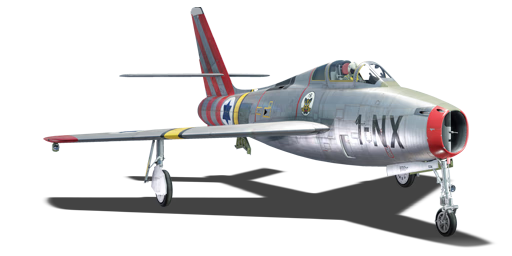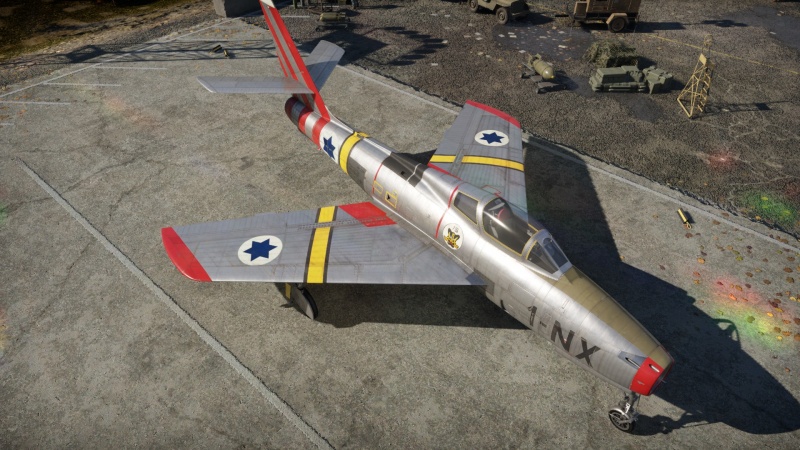F-84F (Israel)
| This page is about the Israeli strike aircraft F-84F (Israel). For other versions, see F-84 (Family). |
Contents
Description
The F-84F Thunderstreak is a premium rank Israeli strike aircraft with a battle rating of (AB), (RB), and (SB). It was introduced in Update "Wind of Change".
General info
Flight performance
| Characteristics | Max Speed (km/h at 0 m - sea level) |
Max altitude (metres) |
Turn time (seconds) |
Rate of climb (metres/second) |
Take-off run (metres) | |||
|---|---|---|---|---|---|---|---|---|
| AB | RB | AB | RB | AB | RB | |||
| Stock | 1,090 | 1,067 | 29.7 | 30.9 | 30.7 | 28.8 | 3,000 | |
| Upgraded | 1,111 | 1,102 | 26.5 | 28.0 | 45.9 | 38.0 | ||
Details
| Features | |||||
|---|---|---|---|---|---|
| Combat flaps | Take-off flaps | Landing flaps | Air brakes | Arrestor gear | Drogue chute |
| ✓ | ✓ | ✓ | ✓ | X | ✓ |
| Limits | ||||||
|---|---|---|---|---|---|---|
| Wings (km/h) | Gear (km/h) | Flaps (km/h) | Max Static G | |||
| Combat | Take-off | Landing | + | - | ||
| 533 | 515 | 417 | ~11 | ~3 | ||
| Optimal velocities (km/h) | |||
|---|---|---|---|
| Ailerons | Rudder | Elevators | Radiator |
| < 630 | < 600 | < 650 | N/A |
Engine performance
| Engine | Aircraft mass | |||||
|---|---|---|---|---|---|---|
| Engine name | Number | Basic mass | Wing loading (full fuel) | |||
| Wright J65-W-7 | 1 | 6,667 kg | 279 kg/m2 | |||
| Engine characteristics | Mass with fuel (no weapons load) | Max Takeoff Weight | ||||
| Weight (each) | Type | 8m fuel | 20m fuel | 29m fuel | ||
| 1,260 kg | Axial-flow turbojet | 7,177 kg | 7,838 kg | 8,368 kg | 8,935 kg | |
| Maximum engine thrust @ 0 m (RB/SB) | Thrust to weight ratio @ 0 m (100%) | |||||
| Condition | 100% | WEP | 8m fuel | 20m fuel | 29m fuel | MTOW |
| Stationary | 3,470 kgf | N/A | 0.48 | 0.44 | 0.41 | 0.39 |
| Optimal | 3,470 kgf (0 km/h) |
N/A | 0.48 | 0.44 | 0.41 | 0.39 |
Survivability and armour
The F-84F has decent armour surrounding the pilot including bulletproof glass and steel plates. However there is no armour for critical systems and everything is packed together in the middle of the aircraft. A few hits to the middle of the aircraft will most likely destroy it.
Modifications and economy
Armaments
| Ballistic Computer | |||
|---|---|---|---|
| CCIP (Guns) | CCIP (Rockets) | CCIP (Bombs) | CCRP (Bombs) |
| |
|
|
|
Offensive armament
The F-84F (Israel) is armed with:
- 4 x 12.7 mm M3 Browning machine guns, nose-mounted (300 rpg = 1,200 total)
- 2 x 12.7 mm M3 Browning machine guns, wing root-mounted (300 rpg = 600 total)
Suspended armament
The F-84F (Israel) can be outfitted with the following ordnance:
- Without load
- 12 x HVAR rockets (inner pylons)
- 12 x HVAR rockets (outer pylons)
- 24 x HVAR rockets
- 42 x FFAR Mighty Mouse rockets
- 42 x FFAR Mighty Mouse rockets + 2 x 1,000 lb LDGP Mk 83 bombs (2,000 lb total)
- 42 x FFAR Mighty Mouse rockets + 2 x 2,000 lb LDGP Mk 84 bombs (4,000 lb total)
- 12 x HVAR rockets + 2 x 1,000 lb LDGP Mk 83 bombs (2,000 lb total)
- 12 x HVAR rockets + 2 x 2,000 lb LDGP Mk 84 bombs (4,000 lb total)
- 4 x 250 lb LDGP Mk 81 bombs (1,000 lb total)
- 4 x 500 lb LDGP Mk 82 bombs (2,000 lb total)
- 4 x 1,000 lb LDGP Mk 83 bombs (4,000 lb total)
- 2 x 2,000 lb LDGP Mk 84 bombs (4,000 lb total)
- 2 x 2,000 lb LDGP Mk 84 bombs + 2 x 1,000 lb LDGP Mk 83 bombs (6,000 lb total)
- 4 x BLU-1 incendiary bombs
- 2 x BLU-1 incendiary bombs + 12 x HVAR rockets
- 2 x BLU-1 incendiary bombs + 42 x FFAR Mighty Mouse rockets
Usage in battles
Describe the tactics of playing in the aircraft, the features of using aircraft in a team and advice on tactics. Refrain from creating a "guide" - do not impose a single point of view, but instead, give the reader food for thought. Examine the most dangerous enemies and give recommendations on fighting them. If necessary, note the specifics of the game in different modes (AB, RB, SB).
Radars
The F-84F is equipped with an AN/APG-30 rangefinding radar, located in the nose of the aircraft. It will automatically detect other planes within the scanning area and display the range to the closest target. It is linked with a gyro gunsight and can help with aiming at close range.
| AN/APG-30 - Rangefinding radar | |||
|---|---|---|---|
| Maximum Tracking Range |
Minimum Tracking Range |
Azimuth Tracking Angle |
Elevation Tracking Angle |
| 2,750 m | 300 m | ±9° | ±9° |
Pros and cons
Pros:
- Gets an airspawn as a strike aircraft
- Six .50 caliber machine guns as main armament gives plenty of firing time to get a hit in
- Diverse payload options in rockets or bombs
- Top speed matches that of other contemporary aircraft
Cons:
- .50 caliber armament is not very powerful, requires longer hit times to do sufficient damage to enemy aircraft
- Rate of climb is rather poor
- Payload restricted to one type of ordnance, rockets or bombs
- Turn time is worse than other contemporary fighters
History
In 1956, Egyptian president Gamal Abdel Nasser made plans to construct a dam across the river Nile at Aswan - a massive project that could radically change the Egyptian economy and solve many dire problems he had been facing. However, the World Bank refused his request for a loan, without which the project could not proceed. In retaliation, Nasser declared his country's sovereignty over the Suez Canal - the artificial waterway connecting the Indian Ocean to the Mediterranean Sea - which until that point had been co-owned by the UK government and the French public. While Egypt's army moved to take the canal from its European civilian operators, Egyptian naval forces moved to block the Straits of Tiran at the mouth of the Red Sea to prevent any Israeli ships from entering it. This move marked the beginning of an event known today as the "1956 Suez Crisis".
The United Kingdom and France were determined to retake the canal; however it was clear to the leaders of both countries that the world (and particularly the United States) would see such action as an unwarranted invasion, or even as an attempt by the Europeans to re-colonize Egypt. Fortunately for them, Nasser's maneuver to block the Straits of Tiran violated the 1949 cease-fire agreement with Israel and provided it with a legitimate casus beli. As such, Israel, France and the UK began a series of clandestine meetings in which their leaders discussed a tri-partate operation. It was finally decided that Israel would use its casus beli to attack the Suez Canal, whereupon France and the UK would invade under the pretense of a "peace-keeping operation" and retake the canal for themselves.
Israel, however, had one major problem with the operation: The Israeli Air-Force (IAF) was still relatively weak, especially compared to the Soviet-equipped Egyptians; It had only been established less than a decade earlier, and half of its combat planes were still World-War II era prop-driven fighters. With most of the IAF's jet fighters busy supporting the planned airborne invasion of the Sinai Peninsula, the IAF would not be able to defend Israel itself against any Egyptian attempt to bombard Israeli cities using IL-28 jet bombers. Therefore, in one of the final meetings with the French and British representatives, Israel's Prime Minister David Ben-Gurion made a key demand: The French Air Force would have to take over the duties of protecting the skies over Israel. France agreed to this demand.
Shortly before the start of the operation, three French air squadrons were relocated to bases in Israel. Totaling 36 jet fighters, these squadrons would be tasked solely with protecting the Israeli airspace against any incursions by Egyptian aircraft. However, in order to mask France's involvement in the Israeli invasion, the planes would have to be disguised as IAF planes. Three new IAF squadrons were "invented" for them, and the planes themselves were repainted in IAF colors and markings. On their way to Israel, the planes had to make a stop-over at Brindisi, Italy; the Italian authorities were told that these were Israeli jets being flown back from repairs in France.
One of these French squadrons, renamed "IAF Squadron 200" for the duration of the operation, brought 18 F-84F fighter jets. It was stationed at Lod air force base (next to Israel's main international airport) and was tasked with providing the first line of defense. However, by the end of the short war it turned out that Ben-Gurion's worries had been unfounded: the Egyptians were either reluctant or incapable of sending bombers into Israeli airspace, and the three French squadrons saw no action during the war. With the exception of one false alarm, none of the French planes stationed in Israel ever took off.
Media
Excellent additions to the article would be video guides, screenshots from the game, and photos.
See also
- F-84 (Family)
- F-84F (France) - Same Aircraft in the French Tree
External links
| Republic Aviation Corporation | |
|---|---|
| Fighters | P-43A-1 |
| P-47D-22-RE · P-47D-25 · P-47D-28 · P-47M-1-RE · ⋠P-47M-1-RE · P-47N-15 | |
| Jet Aircraft | F-84B-26 · F-84F · F-84G-21-RE |
| F-105D | |
| Export | J9 Early* |
| ␗P-43A-1 | |
| ▄Thunderbolt Mk.1 · ▄P-47D-22-RE · ␗P-47D-23-RA · ▂P-47D-27 · ␗P-47D-30 · ▄P-47D-30 · ␗F-47N-25-RE | |
| ◄F-84F · ▄F-84F (Italy) · ▄F-84F (France) · F-84F IAF · F-84F | |
| ␗F-84G-21-RE · ▄F-84G-21-RE · ▄F-84G-26-RE · ␗F-84G-31-RE | |
| Captured | ▀P-47D-16-RE · ▀P-47D |
| *The company was named "Seversky Aircraft Company" before being renamed in 1939 | |
| Israel jet aircraft | |
|---|---|
| Kfir Canard · Kfir C.2 · Kfir C.7 · Nesher | |
| Britain | |
| Meteor | Meteor NF.13 · Meteor F.8 |
| France | |
| Vautour | Vautour IIA · Vautour IIN |
| Super Mystere | Sambad · Sa'ar |
| Mirage III | Shahak |
| Other | M.D.450B Ouragan · Mystere IVA |
| USA | |
| F-84 | F-84F |
| A-4 | A-4H · A-4E Early (M) · A-4E · Ayit |
| F-4 | Kurnass · Kurnass 2000 |
| F-15 | Baz · Baz Meshupar · F-15I Ra’am |
| F-16 | Netz · F-16C Barak II · F-16D Barak II |
| Israel premium aircraft | |
|---|---|





